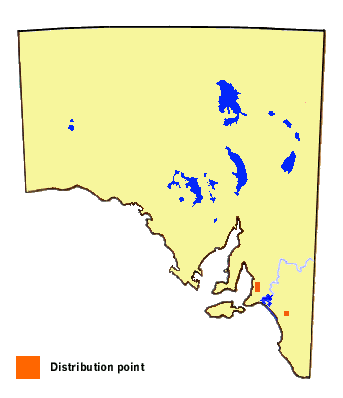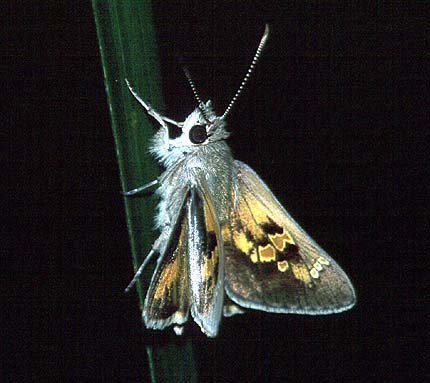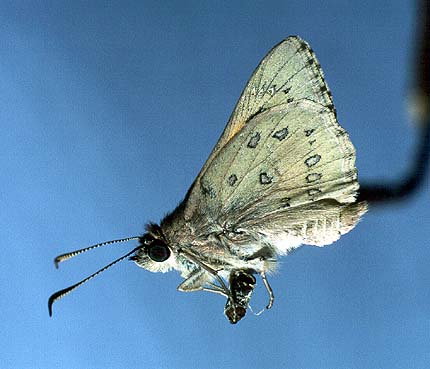-
Larval Food Host
-
Lomandra densiflora (soft-tussock mat-rush),
L. fibrata (Mount Lofty mat-rush),
L. filiformis, L. multiflora dura (hard mat-rush),
L. nana (small mat-rush),
L. sororia (sword mat-rush) (Asparagaceae).
It has a particular liking for L. nana. The skipper uses Lomandra filiformis
in the eastern states.This potential hostplant along with Lomandra longifolia
only occurs in the Lower Southeast Region of South Australia. Neither of these potential
hostplants are known to be utilised in South Australia, although in captivity larvae will
transfer to L. longifolia. The skipper may also locally utilise other Lomanda
species in South Australia as the butterfly has historically been recorded from Tintinara
(Upper Southeast Region) in which locality none of the documented hostplants are presently
known to occur. The larvae feed on the leaves.
-
Eggs
-
Large, initially pale yellow, hemi-spherical (domal) with strong vertical ribs 18-25,
laid singly on the hostplant. If the egg is fertile, then after a couple of days it
acquires a large red dorsal spot, (with no extra red band). Eggs are usually laid on
hostplant situated in partial shade.
-
Larvae
-
Fat, about 28 mm long, having a shape typical for the genus.
-
Pupae
-
Brown, with darker markings, 19-21 mm long, short and fat, with minimal ornamentation
about the head, abdomen bristly, and the cremaster is very long and spinose. The pupa
is typical for the genus. Pupation takes place during spring, either in the final
larval shelter or the larva may leave the hostplant and pupate in leaf or bark debris
around the base of the hostplant.
-
Flight Period in South Australia
-
Late September to early December, usually flying later in elevated areas.
Only one brood a year.

-
Distribution
-
Presently confined to a small group of elevated areas about the summit of Mount Lofty.
It has historically been recorded from Tintinara in the Upper Southeast Region,
in which area it is now probably extinct. Likely habitat at that location was probably
the pink and blue gum open woodlands with a low heath and Lomandra understorey,
which has now been cleared for agriculture. Interestingly, it has not been recorded
from other areas in the Southeast Region, even though its hostplant occurs, although
there is a possibility the skipper may be found in that region in the future within
some of the conserved heathlands. The skipper is also found in the higher rainfall
areas of Victoria, New South Wales, and southern Queensland, mostly along the Great
Dividing Range.

-
Habitat
-
The skipper presently occurs in open woodland and forest, in high rainfall areas.
It prefers its hostplant to be in partial shade and uncongested by other plants.
The skipper, particularly the males, also has a strong preference for ridges
and hill-tops, and the presence of hilly or dune areas may be a habitat
pre-requisite. The early stages of the skipper may also require humid conditions,
or at least require its hostplant to remain in a soft pristine condition during
the hot summer and autumn months.
-
Conservation Status in South Australia
-
Vulnerable. Common in the eastern states.
-
Threats
-
Known colonies occur within the prime elevated bushland areas of the suburban
Adelaide Hills, and are therefore subject to the continuous effects of
urbanisation. These colonies are now largely restricted to conservation
parks. As the habitat area is small these colonies are also subject to the
vagaries of bushfires which are a regular feature of the Adelaide Hills.
-
Conservation Strategy
-
Remaining native bushland habitat in the Adelaide Hills, particularly that
occurring on hill-tops, needs to be conserved. As favourable habitat for
the skipper occurs elsewhere in the Southern Mt Lofty Range, it is possible
the skipper's historical range was much more extensive than is presently
documented, with the combined effects of agriculture, urbanisation and
bushfires causing its demise.Therefore, consideration should be given to
repopulation programs for the skipper, into high rainfall elevated
conservation areas within the Southern Mt Lofty Range.



